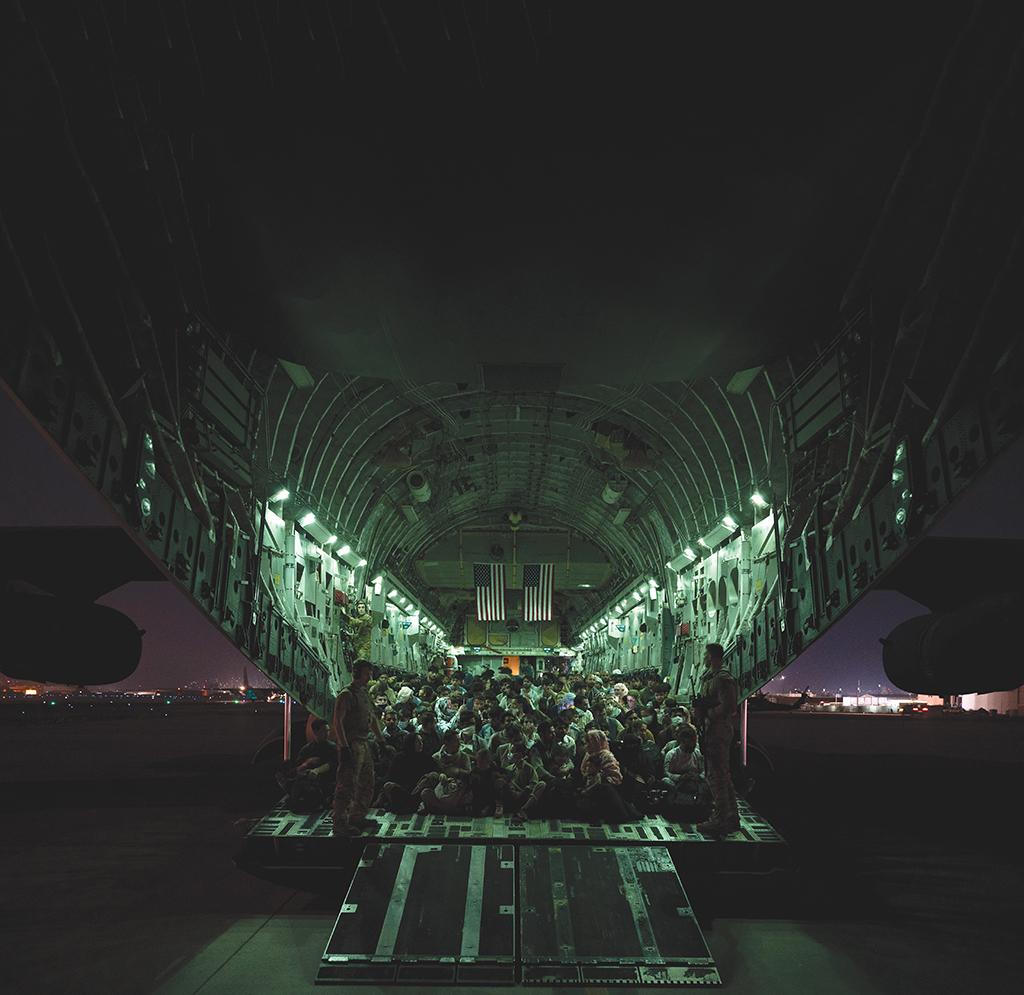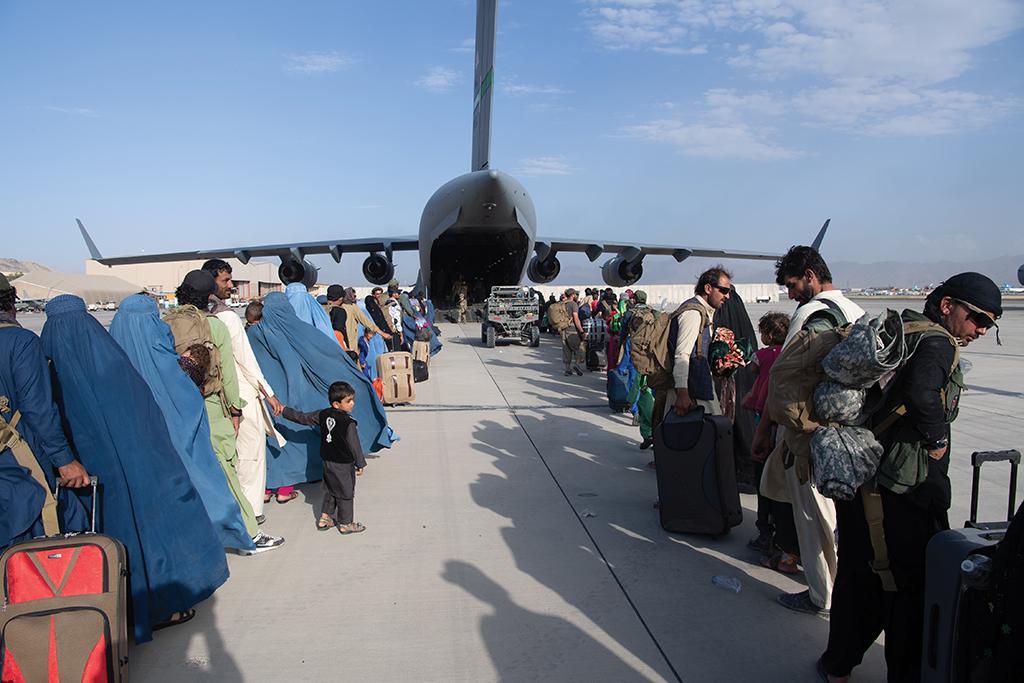Historic Air Evacuation Unfolds Amid Chaos, Tragedy In Kabul

An often chaotic air evacuation by hundreds of military airlifters from multiple countries aimed at transporting an unprecedented total of more than 100,000 people from Kabul is underway, following the Taliban’s sudden seizure of Afghanistan.
The scale and speed of the Afghanistan airlift has already dwarfed the operation that evacuated about 57,000 South Vietnamese from Saigon in 1975.
- C-17s, A400Ms and C-130s star in evacuation flights
- A perilous path lies before Aug. 31 deadline
By Aug. 25, an impromptu fleet of mostly Boeing C-17s, Airbus A400Ms and Lockheed Martin C-130s had carried away more than 101,000 people from a disordered scene outside Hamid Karzai International Airport. But more than 10,000 still waited along a tense airfield perimeter patrolled by Taliban fighters, hoping not to be left behind by U.S. forces.
In the hours after two deadly terrorist bombings struck the airport gate on Aug. 26, killing at least 11 Marines and one Navy medic, Biden administration officials said they would press on with a plan to withdraw all U.S. forces by Aug. 31—only 11 days shy of the 20th anniversary of the attacks on Sept. 11, 2001, which were planned by the al-Qaida terrorist group based in Afghanistan.
The massive evacuation operation unfolded slowly as it started in late July, with a total of 5,600 people, including U.S. citizens and Special Immigrant Visa holders, leaving the country on military transports through Aug. 14. But the surprise collapse of the Afghan National Army, following an offensive blitz by Taliban forces starting in early August, caught both U.S. planners and many evacuation seekers off guard.
As Taliban forces paraded through the captured presidential palace in Kabul on Aug. 15, thousands of foreign nationals and Afghan allies of the defeated NATO-backed government rushed to the besieged airport. But an influx of thousands of U.S. troops did not arrive in time to secure the airfield’s perimeter.
By Aug. 16, a C-17 was rushed by desperately fleeing Afghans as it landed at the airport. The breakdown of security forced the crew to decide to depart immediately, leading to a tragic scene that included at least four deaths of Afghans attempting to stow away on the C-17’s exposed exterior as it took flight.
“The past week has been heartbreaking,” said President Joe Biden in an Aug. 20 press conference. “We’ve seen gut-wrenching images of panicked people acting out of sheer desperation.”
The arrival of about 4,500 soldiers from the U.S. Army’s 82nd Airborne Division helped to stabilize security within the airport’s perimeter, although those seeking flights still were required to traverse the harrowing gauntlet through Taliban checkpoints.

As security tightened, the pace of the airlift accelerated quickly. Within a week, the hastily assembled evacuation fleet, including 200 U.S. aircraft alone, ramped up to carry 50,000 people out of Afghanistan over a three-day period, Aug. 22-24—equaling the six-month-long operation from Saigon 46 years ago. The program racked up new transport records, including the sight of 823 evacuees packed onto the floor of a single C-17. As airlift operations peaked on Aug. 24, a military transport aircraft departed Kabul every 39 min., said Army Maj. Gen. Hank Taylor, deputy director of the Joint Staff for Regional Operations.
The evacuation mission was expected to ramp down in the last days before the Aug. 31 deadline. Thousands of eligible evacuees including U.S. and other foreign citizens may not be able to reach the airport safely in time, and a Taliban spokesman “discouraged” Afghans from attempting to flee. The U.S. appears to have little leverage over a deadline that the Taliban declined to extend.
“In those last couple of days, we’re going to try to preserve as much [military] capability as we can at the airport, as you might imagine,” said Pentagon spokesman John Kirby on Aug. 25. “So, in those last couple of days, we will begin to prioritize military capabilities and military resources to move out.”

In addition to the U.S. contribution, countries across the world quickly ratcheted up efforts to evacuate their diplomats, support staff and local employees and their families from Kabul.
Several European countries established hub-and-spoke operations, flying back and forth to Kabul from airfields in the Middle East and Central Asia. Germany, for example, has been flying its Airbus A400Ms into Afghanistan from Tashkent, Uzbekistan, where the chartered Lufthansa A340s have flown evacuees back to Germany.
The UK’s C-17, C-130J Hercules and A400M aircraft have been flying into Kabul from Al Minhad AB in the United Arab Emirates. Passengers are then transferred to the UK on military and commercial Airbus A330s. Meanwhile, France’s A400Ms and C-130s have been flying from Al-Dhafra AB near Abu Dhabi, where the French Air Force has an enclave. Canada’s airlifters are flying to Afghanistan from Kuwait. Scandinavian countries and the Netherlands are operating from Pakistan.
Although most nations’ airlift operations have been unilateral in nature, the evacuation missions of several European countries are being arranged by European Air Transport Command (EATC), a multinational command cell that coordinates the air transport movements of Belgium, France, Germany, Italy, Luxembourg, the Netherlands and Spain.
The EATC created an ad-hoc cell coordinating Afghan evacuation missions, organizing some 120 missions and assisting in the evacuation of 15,000 people. Like the U.S. operation, several European countries have sent special forces troops to provide security. Germany even airlifted in two H145M special-forces helicopters, which were used to retrieve nationals trapped beyond the perimeter of the airport.
Perhaps more than ever, the Afghan airlift has once again focused attention on air mobility, with several European countries forced to rely on the efforts of their neighbors to get citizens out of Kabul.
Switzerland had planned to use a commercial airliner to evacuate its personnel, but when the security situation worsened, Swiss nationals in Kabul had to leave on German or U.S. evacuation flights. Irish plans to send troops to support the evacuation were hampered by the country’s lack of a military airlift capability.
The U.S. Defense Department activated 18 aircraft by six airlines in the Civil Reserve Air Fleet. Their role was to help the military fleet haul thousands of evacuees from regional safe havens in the Middle East to clearing bases in Europe.
The airlift may also lead to renewed questions over recent decisions by several governments to reduce their airlift fleets, including retiring aging McDonnell Douglas KC-10 and Boeing KC-135 tankers operated by the U.S. Air Force. The UK may feel pressured to review a controversial decision to retire its fleet of 14 C-130Js by the end of 2023, shrinking the airlift capability of the Royal Air Force by 30%.
“Even before the Kabul airlift, this [cut] looked strategically incoherent with the ‘Global Britain’ ambition set out in the Integrated Review,” wrote Sophy Antrobus, a research associate at the Freeman Air and Space Institute of King’s College London. “After the Kabul airlift, it looks reckless.”







Comments
The Taliban began their slow takeover of Afghanistan months ago immediately after our president set his withdrawal deadline. Didn’t see that one coming?
There should be sober reflection on the tactics or lack of during this withdrawal. Why was Bagram AB given up to the Taliban? Didn’t anyone realize how valuable that asset would be if and when things turned south? Et cetera.
Finally nation building didn’t work in Vietnam or Afghanistan but it seems to have worked in S Korea, Japan, Germany. Why? Where did we stay? Where did we leave?
In any future war, we should consider:
A) we go, break everything, then leave with a warning don’t make us come back.
B)we go, break everything, then nation build. But then you cannot leave. Otherwise history shows us you will lose all your treasure and lives spent nation building in a very miserable ending.